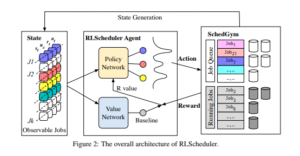Quantum Cryptography, Radiation Damage, Human Settlements & More
In this bimonthly feature, HPCwire highlights newly published research in the high-performance computing community and related domains. From parallel programming to exascale to quantum computing, the details are here.
 Scheduling HPC batch jobs using deep reinforcement learning
Scheduling HPC batch jobs using deep reinforcement learning
Efficient job scheduling can dramatically increase the efficiency of an HPC system. This paper, written by a team from the University of North Carolina at Charlotte and Iowa State University, presents “RLScheduler,” which uses deep reinforcement learning to schedule independent batch jobs in HPC environments. “RLScheduler,” the authors write, “is able to autonomously learn how to effectively schedule HPC batch jobs, targeting a given optimization goal.” The authors describe their results, which show that RLScheduler outperforms existing heuristic scheduling algorithms.
Authors: Di Zhang, Dong Dai, Youbiao He and Forrest Sheng Bao.
Using HPC to observe human dynamics at the planet level
Large-scale human settlement mapping can be used to study human populations like those of any other animal species. A team of authors from Oak Ridge National Laboratory explored human settlements’ morphology using deep learning experiments based on convolutional neural networks. They demonstrated that the computations could be scaled to some of the largest HPC architectures, yielding unprecedented speeds and spatial resolutions.
Authors: Budhu Bhaduri, Dalton D. Lunga, Lexie Yang, Jacob Mckee, Melanie Laverdiere, Kuldeep R. Kurte and Jibonananda Sanyal.
Applying low-power HPC on Arm platforms in astrophysics
Increasingly, power draw is a major concern for high-performance computing. In this paper, written by a team from the National Institute of Astrophysics in Italy, the authors evaluate the energy consumption of Arm platforms (using both CPUs and GPUs) on a real astrophysics application, with the aim of further low-power HPC applications in astrophysics. They detail the extent to which the platforms can be used for those purposes and highlight the utility of emulated double precision.
Authors: Giuliano Taffoni, Sara Bertocco, Igor Coretti, David Goz, Antonio Ragagnin and Luca Tornatore.
 Simulating the performance of scientific applications on HPC systems
Simulating the performance of scientific applications on HPC systems
Scientific applications often contain complex tasks that can induce load imbalances when they are executed on HPC systems. This paper, written by researchers from the University of Basel, the German Aerospace Center and Mississippi State University, discusses dynamic loop self-scheduling (DLS) techniques, which can improve performance. They apply a new simulation approach for selecting the appropriate DLS technique, showing that simulations can realistically predict the performance of DLS techniques across different applications and systems.
Authors: Ali Mohammed, Ahmed Eleliemy, Florina M. Ciorba, Franziska Kasielke and Ioana Banicescu.
Examining cryptography in quantum computing
With quantum computing standing to break many existing encryption methods, the hunt is on for a new method of encryption. In this study, a team from Pace University explores one of the few experiments on quantum encryption by analyzing the results of tests on the IBM Cloud Server. The authors also examine the possible application of quantum public key encryption and quantum key distribution.
Authors: Pam Choy, Dustin Cates, Florent Chehwan, Cindy Rodriguez, Avery Leider and Charles C. Tappert.
Using multiscale simulation to understand radiation damage in nuclear reactors
Nuclear reactors damage their structural materials over time, eventually leading to failure. In this paper, a team from the University of Science and Technology Beijing and the China Institute of Atomic Energy discuss how HPC can help. By using HPC to operate multiscale simulations, researchers can see the microstructural evolution of irradiated reactor materials, allowing plant operators to more easily maintain nuclear reactors.
Authors: Dandan Chen, Xinfu He, Genshen Chu, Xiao He, Lixia Jia, Zhaoshun Wang, Weng Yang and Changjun Hu.
 Using algorithm-based fault tolerance for parallel stencil computations
Using algorithm-based fault tolerance for parallel stencil computations
Modern HPC systems are subject to soft errors, sometimes causing silent data corruptions (SDCs). In this paper, written by Aurélien Cavelan and Florina M. Ciorba, the authors discuss protecting a class of computational kernels (stencils) against SDCs when executing on parallel HPC systems. “The main contribution is the novel checksum interpolation method,” Cavelan wrote to HPCwire. “This allows [us] to detect and correct errors (bit-flips) during the execution of an arbitrary stencil-based application.”
Authors: Aurélien Cavelan and Florina M. Ciorba.
Do you know about research that should be included in next month’s list? If so, send us an email at [email protected]. We look forward to hearing from you.








Gloss